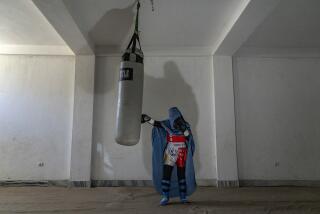Reviving Afghanistan
- Share via
One day Kabul was silent, lifeless: women gliding in their shroud-like burkas, men in look-alike beards, streets devoid of bustle. The next day, so swiftly, long-banned radios and televisions were dug up and plugged in, shrouds pushed aside, hair and faces of women shyly emerging, men crowding the barbershops.
The speed of the Taliban’s fall in Afghanistan thrusts the need to build a civil society to the foreground. Success will require a longer struggle than the military campaign has, with bitter quarrels among ethnic groups unavoidable. But there is a model, imperfect yet still valuable: Afghanistan before the pro-Moscow coups and subsequent Soviet invasion nearly a quarter-century ago.
In the 1970s, before and after a cousin overthrew King Mohammad Zaher Shah, Kabul was a capital city of sturdy buildings, good restaurants and a university that educated doctors, scientists and teachers. Women worked in government offices; some covered their heads and some did not. Other cities were more conservative, and remote villages were more traditional still. It was not a paradise or a democracy on the Western, liberal model. Illiteracy was the rule, and heavy-handed security kept dissidents in check. Still, it was a functioning state. The population was Muslim, but magnificent Buddhist statues at Bamian spoke of earlier times and different cultures.
Ten years of war against Soviet invaders united ethnic groups in opposition but ravaged the countryside. After the Soviet withdrawal in 1989 and the end of communist rule in 1992, four years of brutal, contested rule by the Northern Alliance turned Kabul to rubble. The fanatical Taliban took over and barred women from working and girls from schools. It destroyed the Bamian statues. It sheltered Osama bin Laden. Fortunately, the Taliban is on the run. Unfortunately, the Northern Alliance is back in Kabul. Their promise to be temporary caretakers must be enforced.
The most urgent need is preventing starvation. A multilateral peacekeeping force, with United Nations authorization, must ensure that food from foreign donors gets to the hungry, not to merchants or soldiers.
Politically, there is no substitute for a broad-based government that includes ethnic Pushtuns, who make up more than 40% of the country, and Tajiks, Hazaras and Uzbeks, the main components of the Northern Alliance. Multiethnic governments existed in the past and can again now.
The chief immediate obstacle is the self-proclaimed post-Taliban president, Burhanuddin Rabbani, who plans to return to Kabul from exile. He is a strict Islamist who supported Saddam Hussein in the Gulf War. Rabbani also has kept the Northern Alliance from meeting with other ethnic groups to discuss a post-Taliban government. He must be shoved aside before he consolidates power.
The United States and the wealthier nations in the anti-terror coalition will have to foot the bills for rebuilding Afghanistan. With that aid comes leverage. If enough money is available, rival ethnic groups can be persuaded to set aside their quarrels. If peace takes hold, educated Afghans who fled the Soviets, then the Northern Alliance, then the Taliban, may be coaxed to return from exile to help staff the ministries and start businesses.
The United States and most other nations turned away when the Afghans drove the Soviets out 12 years ago. Repression, starvation, terror and Osama bin Laden were the result. This time, a less bitter history of earlier years beckons for revival.
More to Read
Sign up for Essential California
The most important California stories and recommendations in your inbox every morning.
You may occasionally receive promotional content from the Los Angeles Times.













